| Srl | Item |
| 1 |
ID:
131882
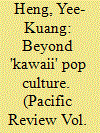

|
|
|
|
|
| Publication |
2014.
|
| Summary/Abstract |
Many studies of Japan's soft power are premised on the 'affective' dimensions of its kawaii pop culture that generate liking or interest. While entirely warranted, emphasising cultural attraction does not do sufficient justice to the multi-faceted foundations of Japanese soft power. Neither does it recognise other components of Joseph Nye's soft power framework stressing the 'normative' appeal of policies that reflect global norms. This article investigates the 'normative' dimensions of Japan's soft power on climate change, and whether it translates into international influence, as Nye predicted. The first section examines the Cabinet's 2010 New Growth Strategy, identifying a potential source of 'normative' soft power in its self-proclaimed desire to reinvent Japan as a 'trouble-shooting nation on global issues', specifically environmental challenges. Next, it analyses how Japanese entities (government, corporations, and NGOs) can transmit 'normative' soft power, and obstacles encountered. These transmission mechanisms include 'Cool Earth Partnership' programmes, the 'Future City Initiative' and the values-based Satoyama Initiative. The final section addresses conceptual implications that arise, and assesses whether Japan's 'normative' soft power has paid dividends. Drawing from literature on pioneer states and external reviews of Japan's alignment with key climate norms, the paper suggests that Japan's normative soft power is lacking in driving agendas at global climate forums. At a pragmatic problem-solving level, however, Japan is increasingly perceived as an attractive source of transferable solutions, reflecting climate norms such as developing eco-friendly technologies and providing assistance to help vulnerable countries mitigate climate change
|
|
|
|
|
|
|
|
|
|
|
|
|
|
|
|
| 2 |
ID:
116205
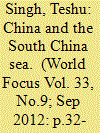

|
|
|
| 3 |
ID:
114917
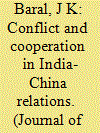

|
|
|
|
|
| Publication |
2012.
|
| Summary/Abstract |
India-China relations, though occasionally showing signs of peace and cooperation, have often been afflicted by tension and mistrust. With the potential to make big contributions to regional peace and development, these two Asian powers have, by design or accident, themselves been the sources of regional tension and insecurity to some extent. Besides their internal dynamics, the interplay of interests and moves of their neigbours, and several external powers would have significant bearing on the equation and relations between them.
|
|
|
|
|
|
|
|
|
|
|
|
|
|
|
|
| 4 |
ID:
184955
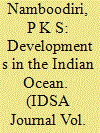

|
|
|
| 5 |
ID:
133597


|
|
|
|
|
| Publication |
2014.
|
| Summary/Abstract |
At first glance, there was no coherent regional and international response to the transitions triggered in the Arab world since December 2010 as external players, both regional and international, had to confront with unceasing alarm the rapidity of change threatening to unravel in critical Arab states. However, as events in the region progressed, a pattern emerged to the external responses, one that was as predictive as it was differentiated. This was exemplified by the counter-revolutionary forces that were assembled against the transition in Bahrain on one hand, and the aggressively interventionist posture adopted towards Libya and Syria on the other. This inconsistency between activism and support for the supposedly democratic spirit of armed resistance groups, but inaction and silence towards the crushed non-violent public opposition elsewhere, clearly betrayed the interest-driven motivations of the external actors involved.
|
|
|
|
|
|
|
|
|
|
|
|
|
|
|
|
| 6 |
ID:
168091
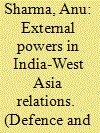

|
|
|
| 7 |
ID:
184925
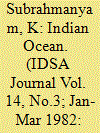

|
|
|
| 8 |
ID:
084891
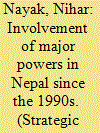

|
|
|
|
|
| Publication |
2009.
|
| Summary/Abstract |
Nepal being a poor landlocked country with a fragile and unstable political system, major external powers providing aid and assistance to Nepal tend to carry an influence on domestic politics, foreign policy, and the socio-economic agenda of the government. These powers have divergent interests and do not coordinate their policies towards Nepal. While some external forces like the United States and China have hidden political and strategic interests, some others like the European Union are engaged in humanitarian issues. There is no unanimity amongst them regarding what kind of political transformation they should endorse or disown to find a solution to the decade-long conflict. Thus, instead of playing a constructive role, these external forces sometimes complicate the process of peace and reconciliation taking shape in Nepal today.
|
|
|
|
|
|
|
|
|
|
|
|
|
|
|
|